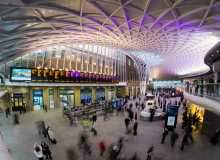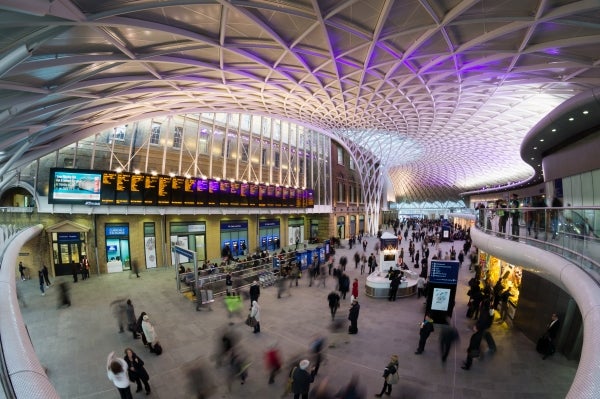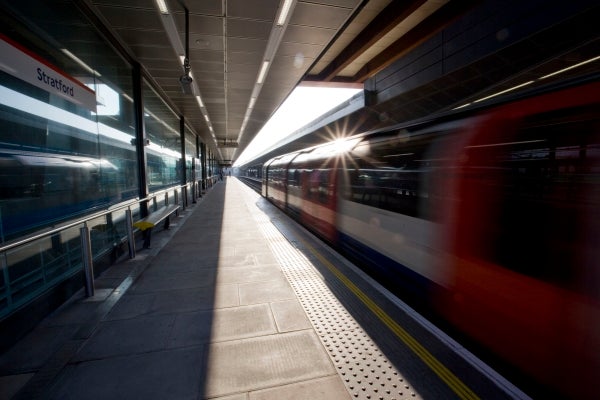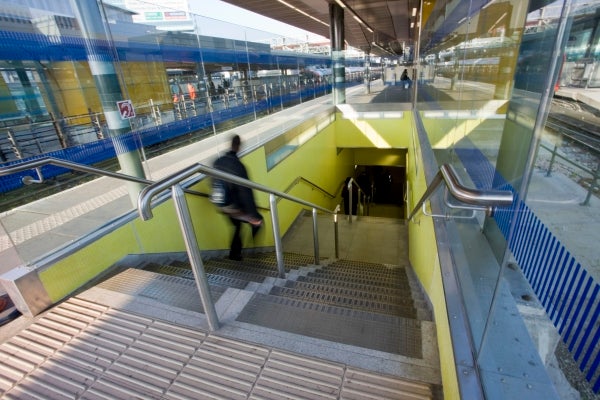
Suffering from years of under-investment and being sidelined, London’s railway and underground train system has always struggled to cope with the 12 million journeys made each day. Its train and Tube stations especially are often overcrowded and jam-packed, with hundreds of commuters hustling along the narrow tunnels and platforms.
During the upcoming 2012 Olympic and Paralympic Games, the railway infrastructure will have to deal with an extra three million passengers every day. With just three months to go to the official opening ceremony of the Games on 27 July, the strained public transport system and infrastructure is still causing the Olympic organisers sleepless nights – despite seven years of planning and a massive budget of £6.5bn alone invested in to rail upgrades.
A big chunk of the money went into railway station upgrades all over the British capital, but in particular Stratford station, located next to the Olympic site in east London. While the major upgrade works there were finalised at the beginning of June 2011, other railway and subway stations are still mantled in construction barricades and scaffolding, and are regularly shutdown on weekends. Seeing that transport has always been the problem child of London’s Olympic preparations, one has to ask, how will the capital’s stations handle the Olympic boom in summer 2012?

London’s King’s Cross station in March 2012.
Preparing London’s train stations for the Olympic boom
"Keeping the capital moving smoothly during the Games will be nothing short of a Herculean task," warned the London Assembly, which oversees the work of the city’s mayor, in March 2012. "Given the scale of the challenges, some disruption to the transport network is inevitable."
How well do you really know your competitors?
Access the most comprehensive Company Profiles on the market, powered by GlobalData. Save hours of research. Gain competitive edge.

Thank you!
Your download email will arrive shortly
Not ready to buy yet? Download a free sample
We are confident about the unique quality of our Company Profiles. However, we want you to make the most beneficial decision for your business, so we offer a free sample that you can download by submitting the below form
By GlobalDataYet, the situation could be worse. An April 2012 report by UK-based policy think-tank Demos suggested that the new transport infrastructure and improvements to existing terminals, especially the massive redevelopment at King’s Cross St. Pancras and the rebuilding of Wembley Park station, are a "big win" for the British capital.
In east London, which was previously held back by a lack of decent transport links, the upgrade of the gateway station to the Olympic Games, Stratford, was successfully completed in June 2011. Work included a new station mezzanine entrance and ticket hall, with ticketing and gate-line facilities, as well as new lifts and staircases to increase passenger capacity. The expansion also included a new Central Line platform, which allows dual-side opening to speed boarding and alighting, a new pedestrian bridge, as well as the integration of previously disparate security, life-safety and customer information systems.
London TravelWatch, the official voice for London’s travelling public, has however criticised the complex nature of the station. Especially the numbering of the platforms, constituted for signalling reasons, which could become difficult to understand for users unfamiliar with the station and lead to temporary gridlocks.
But according to one of the watchdog’s reports from February 2012, the main problems may occur at stations that do not directly serve Olympic venues, such as Paddington and London Bridge. Both stations will be used by large numbers of people interchanging to get to the venues, and in the case of Paddington many visitors will arrive from Heathrow Airport.
Paddington is currently undergoing refurbishment and building works for the Crossrail project, and TravelWatch found major deficiencies, such as poor signage and interchange between modes.
London Bridge train station, on the other hand, is still undergoing major rebuilding for the Thameslink upgrade programme. Even though the work will most likely stop for the duration of the Olympic and Paralympic Games in summer 2012, getting around for travellers who are not familiar with the station is difficult.

Disruption to the transport network during the 2012 Olympic Games will be inevitable.
Commuters: avoiding London’s public transport during the Olympic Games
One of Britain’s leading transport commentators, journalist Christian Wolmar, agreed with TravelWatch and said that problems might be inevitable, particularly at train and subway stations unrelated to the Olympic venues, such as London Bridge, Bank, Farringdon and King’s Cross St. Pancras. He recommended that the main focus now should be on keeping London’s commuters from using public transport during the Games, to not put further strain on the railway and subway infrastructure.
"The main challenge is convincing Londoner’s not to go anywhere near railway and subway stations during the Games," he explained. "That’s the key thing based on making sure that a lot of the people who normally use the Tube or trains don’t necessarily make that journey, or make at least some adjustments to avoid the hotspots. There is going to be a big propaganda campaign to try to get people not to use stations at the absolute peak times and that’s the key challenge, I believe."
Transport for London (TfL) has already started asking residents and work commuters to think about how to change their travel plans in summer 2012. People should try to work from home if possible and avoid dozens of busy Tube stations for the duration of the Olympic and Paralympic Games, including Stratford station. They, as well as the Olympic Delivery Authority (ODA), are confident that the upgrade, combined with London’s commuters changing their habits, will ensure that the city keeps moving in summer 2012.
"We’re confident that as we get closer to the Games, more and more people will start to make alternative travel plans (…) which include working from home, starting work earlier and finishing earlier to avoid busy times, or swapping their normal Tube or rail journey for walking or cycling instead," Silka Todd-Kennedy, TfL spokeswoman, told Australian broadsheet paper The Age in mid-April 2012. To date, however, fewer than one in eight Londoners has given the issue any thought.
The London Organising Committee of the Olympic Games (LOCOG) estimated that spectators will be kept waiting for no longer than 30 minutes at London’s stations to queue to enter major venues, such as the Olympic Park in Stratford, but also admitted that current passenger rates, which exclude the thousands of Olympic visitors, would have to be cut by 30% to reduce waiting times.

Londoners are asked to avoid busy tube stations during the 2012 Olympic and Paralympic Games.
London 2012: Securing Olympic railway stations
One of the main reasons for delays will be security checks at the entrances and exits of every station which serves the Olympic venues. According to experts, safety measures will resemble airport security checks: the ODA is set to use baggage X-ray machines, guards will search bags and CCTV and metal detectors will be used for standard security checks.
British Transport Police (BTP) assistant chief constable Steve Thomas, Gold commander for the Olympics and the joint Department for Transport / Home Office national coordinator for cross modal transport security covering rail, road, sea and air, told Railway Technology earlier in 2012 that the "threat assessment for the Olympics covers pretty much what you would expect: e-crime, fraud, terrorism, public order and crime."
Even though disruption from ordinary events, such as public disorder or a crime such as cable theft, would be more likely to happen than actual terrorism, authorities are planning ways to cope with scenarios ranging from terror bombings to biological attacks at London’s railway and subway stations.
According to Christian Wolmar, "security scares and over-emphasis on security" will be one of the biggest problems at London’s Olympic stations.
"There has to be some flexibility about it," he said. "It could lead to some major problems if safety staff are getting too tight on security. I don’t think station infrastructure itself is a big problem.
"The main problem is the management of the crowds, the security and ensuring that other people don’t crowd the same stations that visitors are using."
Wolmar claimed that, in fact, nobody can predict how London’s railway and subway stations are going to cope with the Olympic masses. "Everybody is guessing at the moment. We will only find out when it happens," he concluded.



